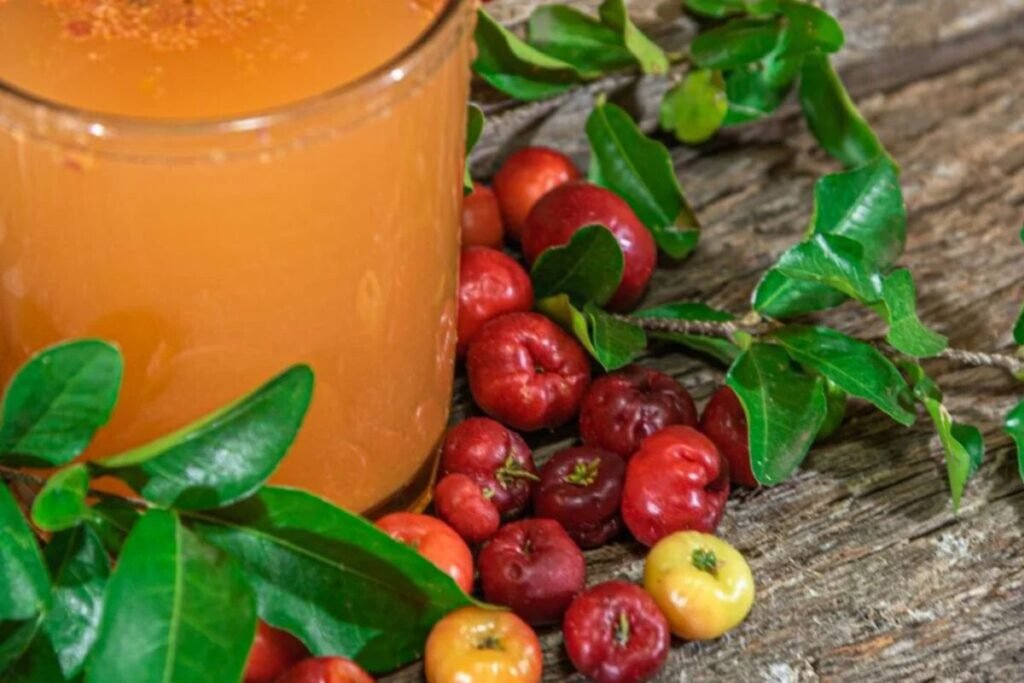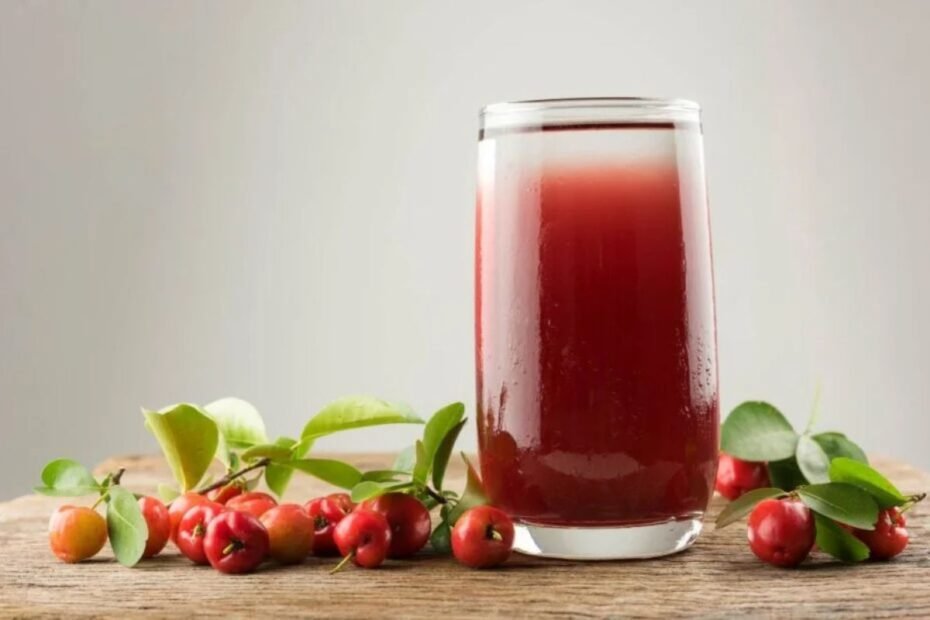Although acerola juice may sound exotic, for many people it has already become a familiar part of everyday life. This is hardly surprising, as the market today offers a wide variety of acerola-based products. These are tablets, freeze-dried powders, and dietary supplements, to lozenges and even specially formulated acerola juices for children. Such diversity clearly suggests that these fruits must offer something truly beneficial.
Often called a superfruit, acerola stands out for its remarkably high vitamin C and other valuable nutrients. In this article, we’ll explore what makes these fruits and their juice so exceptional. Also, how to consume them wisely, and perhaps when it might be best to limit their use.
Meet the Acerola Tree—the Source of this Remarkable Fruit
At first glance, the name Malpighia emarginata may not sound familiar. Yet this is the plant that produces the celebrated acerola fruit. Around the world, people call them Barbados cherry, West Indian cherry, or simply acerola. Belonging to the Malpighiaceae family, this shrub or small tree typically grows to about two or three meters in height.
Visually, it bears some resemblance to the common cherry tree—with its simple oval leaves and delicate pink blossoms. However, it blooms continuously from April to November, producing bright red 1-2 cm diameter berries.
Acerola naturally thrives in tropical climates, including regions of Paraguay, Brazil, Haiti, Puerto Rico, and the Dominican Republic. In recent years, it has also been successfully cultivated in parts of Asia, such as India. Unfortunately, growing the fruit-bearing acerola tree in northern countries is not feasible. Except for a few related species, this plant requires consistently warm, humid, and sunny conditions. As a result, these countries’ consumers must rely on imported acerola products to enjoy its benefits.

What Kind of Product Is Acerola?
You can produce acerola juice from the fruit of the Malpighia emarginata tree—commonly known as acerola. To obtain the juice, you should press the ripe berries, which have a unique flavor, aroma, and color. Acerola juice has a notably tart taste, reminiscent of lemons or other sour citrus fruits. This tanginess comes from its extraordinarily high vitamin C concentration. When the fruits are fully ripe, the juice may carry a subtle sweetness. However, the acidity always remains its dominant characteristic.
The fragrance of acerola juice is light, fresh, and pleasantly fruity. Naturally pressed juice is typically a vivid red or pinkish shade, similar to that of ripe cherries or other red fruits. These sensory qualities can vary slightly depending on the ripeness and the production method.
Nutritional Value of Acerola Juice
People usually do not consume acerola juice in large quantities to provide significant calories (just 30-40 kcal per 100 ml), yet it contains a diverse, nutritionally dense profile. On average, this amount provides approximately 7–10 g of carbohydrates (7–8 g of which are natural sugars and 0.3–1.0 g of fiber), about 0.4 g of protein, and 0.2–0.3 g of fat. Despite its low caloric content, acerola juice stands out for its complex composition and abundance of essential nutrients.
Acerola berries are best known for their astonishing vitamin C content—ranging from 1,000 to 4,000 mg per 100 g (an average of around 1,678 mg), equivalent to an astounding 1,864% of the daily recommended intake. Beyond this primary vitamin, acerola also provides about 4% of the daily requirement of vitamin A (38 µg) and a modest range of B vitamins (B1, B2, B3, B5, B6, and B9), generally contributing 1–6% of the daily value.
Among minerals, manganese takes the lead (0.6 mg, or 26% of the daily requirement), followed by smaller amounts of magnesium, potassium, zinc, calcium, phosphorus, and iron (roughly 1–5% of daily needs).
Acerola fruits are also rich in antioxidant compounds, including flavonoids, anthocyanins, and carotenoids. Researchers have identified numerous phenolic compounds in acerola, such as quercetin-3-glucoside, isorhamnetin, catechin, procyanidin A2, hesperidin, chlorogenic acid, and trans-resveratrol. Thanks to this potent antioxidant profile, acerola-based products can rival—or even surpass—other famously nutrient-dense fruits like blackcurrants (vitamin C), carrots (beta-carotene), or chokeberries (polyphenols). Let’s take a look at Table No. 1, comparing vitamin C contents in popular juices (per 100 ml):

| Juice Type | Approx. Vitamin C Content (mg) in 100 ml |
| Acerola juice | 1,000–4,000* |
| Blackcurrant juice | 180–200 |
| Red pepper juice | 150–200 |
| Kiwi juice | 80–150 |
| Broccoli juice | 80–120 |
| Orange juice | 50–90 |
| Strawberry juice | 60–90 |
| Grapefruit juice | 45–70 |
| Raspberry juice | 40–60 |
| Spinach juice | 30–50 |
| Carrot juice | 5–10 |
| Apple juice | 2–5 |
Health Benefits of Acerola Juice
Acerola juice, bursting with bioactive compounds, offers a spectrum of health benefits:
- The exceptional vitamin C concentration in acerola helps neutralize free radicals, actively enhances the immune response, and protects against chronic inflammatory conditions. These are cancer, atherosclerosis, diabetes, irritable bowel syndrome, arthritis, and cardiovascular disorders.
- Acerola or vitamin C plays a crucial role in collagen synthesis, which maintains skin structure and elasticity helps reduce fine lines and wrinkles. It also shields the skin from UV radiation stress and environmental pollutants.
- Acerola contains dietary fiber that aids digestion, regulates blood sugar levels, and supports gut microbiota balance. Certain carbohydrates protect the stomach lining and stimulate the regeneration of intestinal epithelial cells. Experimental studies have shown that acerola polysaccharides can significantly reduce malondialdehyde (MDA) levels in stomach tissue by as much as 56.5%, especially after ethanol exposure.
- Research suggests that acerola juice may help regulate body weight by inhibiting digestive enzymes such as α-amylase and α-glucosidase. These effects can slow carbohydrate absorption, reduce fat accumulation, and lower blood cholesterol levels. Animal studies have demonstrated that acerola supplementation can effectively decrease body fat and improve lipid profiles.
- Scientific findings indicate that acerola exhibits both anti-inflammatory and possible anti-carcinogenic properties. These effects are primarily attributed to its rich content of polyphenols, flavonoids, and carotenoids, which help suppress inflammatory responses and protect cells from oxidative DNA damage.
- Certain compounds in acerola juice inhibit the growth of harmful bacteria such as Enterococcus, Clostridium cocoides, and Eubacterium rectale, which cause intestinal cell overgrowth and colon cancer. Thus, acerola juice can contribute to a healthier gut environment and protection of intestinal tissues.
- Acerola works hand-in-hand with probiotic bacteria, enhancing growth and activity. This leads to higher production of beneficial acids—such as lactic and acetic acid—while reducing glucose and fructose levels.

Why Acerola Is Notable for Children
Exceptionally rich in vitamin C, acerola juice is an excellent natural supplement to help support children’s nutritional needs. This vitamin is crucial for growing bodies, yet many children struggle to obtain enough from traditional citrus fruits, which can sometimes cause allergic reactions. Acerola juice, on the other hand, provides vitamin C in a gentle, well-tolerated form that our bodies easily absorb and rarely trigger side effects.
One clinical study involving 30 infants aged 3–7 weeks found that acerola juice in their diet significantly improved growth and development. The food industry has also developed child-friendly acerola products—such as gummies or chewables—making supplementation both enjoyable and convenient for younger consumers.
How to Use Acerola Juice
In most cases, you should treat acerola juice not as a regular beverage but as a nutritional supplement. Because pure acerola juice is highly concentrated, it’s essential to follow the dosage guidelines provided on the product label. Typically, freshly pressed (non-concentrated) acerola juice can be consumed in portions of 15–50 ml per day—enough to meet daily vitamin C requirements without exceeding safe limits.
Due to its sharp, tart flavor, acerola juice is best diluted with water or mixed with other fruit juices to soften its acidity and enhance the taste. It also makes a refreshing addition to smoothies or can even be used as an ingredient in salad dressings and marinades, where its bright, citrusy notes elevate the flavor profile. Many people take acerola juice as a natural vitamin C booster during colder months, when the risk of colds and flu tends to increase.

Possible Side Effects of Acerola Juice
While scientific research highlights acerola juice as a beneficial addition to a balanced diet, it may not be suitable for everyone. Some individuals experience adverse effects, especially when consumed in excessive amounts.
- Digestive Discomfort. Because of its high vitamin C and acid content, overconsumption of acerola juice can cause stomach irritation, heartburn, nausea, or diarrhea—effects similar to those caused by other acidic foods.
- Kidney Stone Formation. Large doses of vitamin C can increase oxalate levels in the body, which may contribute to the development of kidney stones, particularly in individuals predisposed to this condition.
- Allergic Reactions. Although rare, some people may be allergic to acerola fruit or its derivatives. Symptoms can include skin irritation, itching, or swelling. Those with known sensitivities should introduce acerola products cautiously.
- Drug Interactions. High doses of vitamin C may interfere with the effectiveness of certain medications, such as chemotherapy agents or anticoagulants. Anyone taking prescription medication should consult a healthcare professional before incorporating acerola juice into their routine.
Even though vitamin C is water-soluble and generally excreted through urine, consistently consuming more than 2,000 mg per day may cause imbalances—potentially leading to digestive issues, headaches, or insomnia. Moderation remains key to safely enjoying acerola’s benefits.
Sources:
- https://fdc.nal.usda.gov/fdc-app.html
- https://www.mdpi.com/1422-0067/25/4/2089
- https://link.springer.com/article/10.1007/s13197-018-3309-5
- https://pubmed.ncbi.nlm.nih.gov/36166922
- https://link.springer.com/article/10.1186/1476-511X-13-24
- https://www.jpeds.com/article/S0022-3476(56)80159-5/abstract
Associative photos © Canva.
